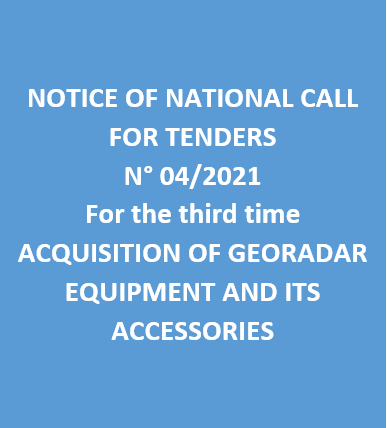| Annual program and technical progress report |
-

Technical Program 2025
-

Activity Report 2023
|
| Geocatalogue |

|
| Invitation to
tender |
-

REALIZATION OF THE TRAINING PLAN FOR THE YEAR 2022
-

ACQUISITION OF TWO SERVICE CARS
-

ACQUISITION OF GEORADAR EQUIPMENT AND ITS ACCESSORIES
|
|
Invest in Tunisia |

|
|
|
|
|
::
Documentation and Editions
>>
Research library
|
| |
|
[
Search by author
]
[
Search keyword
]
[
Search by index
]
[
Search by category
]
|
title of the reference :
|
Sporollinic analysis in El Kef Outcrop (N.W. Tunisia)
|
|
Publication Date:
|
1993
|
|
Author :
|
Meon Henriette
|
|
Catalogue type :
|
Livre
|
|
Catalogue reference :
|
(CSK) Geol. Ustav Dionyza Stura Sporollinic analysis in El Kef Outcrop (N.W. Tunisia) Cretaceous, Tertiary boundary. Palynological analysis gave an interesing flora from marine and terrestrial origins. Dinoflagellates are always prevailing. Here we show results from the study of spore and pollen grain association. It was possible to identify 213 taxa. In the section considered (from Globotruncana falsostuarti zone to Globigerina pseudomenardii zone)the evolution of the sporopollinic flora is expressed by an improverishement, the disappearances are far from compensated by appearances. The lower levels show a mixture of species recorded in tropical Africa and South America and of species with European affinities or of biquitous ones, then the Danian palynoflora is mostly dominated by normapolles which till now found in such proportions only in the northern regions. The influence of climate on the vegetation is obviuos, but the modifications are manifested during quite a long time, the effect of a meteorite impact, showed by geochemistry, cannot explain the evolution. It seems more plausible than an intense volcanism during the Maestrichtian influenced the climate evolution. This work also shows that North Africa was at the boundary between Euramerican and African provinces, the influence of Europa increasing during the Paleocene. bibliogr. palynologie ; spore ; flore ; pollen ; climat ; végétation ; Crétacé ; Tertiaire ; passage Crétacé Tertiaire ; Tunisie ; Tunisie Nord Occidentale ; el Kef Meon Henriette paleontologie
|
|
Indexation decimale :
|
paleontologie
|
|
Keywords :
|
palynologie ; spore ; flore ; pollen ; climat ; végétation ; Crétacé ; Tertiaire ; passage Crétacé Tertiaire ; Tunisie ; Tunisie Nord Occidentale ; el Kef
|
|
Summary :
|
Palynological analysis gave an interesing flora from marine and terrestrial origins. Dinoflagellates are always prevailing. Here we show results from the study of spore and pollen grain association. It was possible to identify 213 taxa. In the section considered (from Globotruncana falsostuarti zone to Globigerina pseudomenardii zone)the evolution of the sporopollinic flora is expressed by an improverishement, the disappearances are far from compensated by appearances. The lower levels show a mixture of species recorded in tropical Africa and South America and of species with European affinities or of biquitous ones, then the Danian palynoflora is mostly dominated by normapolles which till now found in such proportions only in the northern regions. The influence of climate on the vegetation is obviuos, but the modifications are manifested during quite a long time, the effect of a meteorite impact, showed by geochemistry, cannot explain the evolution. It seems more plausible than an intense volcanism during the Maestrichtian influenced the climate evolution. This work also shows that North Africa was at the boundary between Euramerican and African provinces, the influence of Europa increasing during the Paleocene.
|
|
Exemplaries :
|
TU1804
|
|
|
|
|
|
|
|



